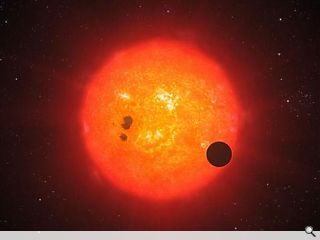Earthly neighbour observed
December 17 2009
Astronomers have detected a likely water rich world so close to Earth that it can be seen with an amateur 16 inch telescope on the ground.Dubbed a “Super Earth” the planet, catchily titled GJ 1214b, is 2.7 times the mass of Earth and closely orbits a very low mass red star dubbed an M dwarf, some 40 light years from us.
Despite temperatures of around 190 degrees the high atmospheric pressures make the presence of liquid water probable although the harsh conditions are felt unlikely to support elaborate forms of life.
Until very recently scientists believed that Earth like worlds offered the most favourable conditions for the evolution of life but with the discovery of “Super Earths” some believe that conditions here are in fact not optimal, evidenced by frequent mass extinctions.
Named for their size, in the region of 2 to 10 times the Earth’s mass, plate tectonics on these worlds is much more active (an essential condition for complex chemistry and recycling carbon dioxide) and have highly stable orbits.
Dimitar Sasselov, professor of Astronomy at Harvard University said: “Earth is a marginal planet when it comes to conditions we would like to see for complex life. In the family of Earth-like planets, the sweet spot for complex chemistry and biochemistry to emerge and sustain itself lies in planets larger than the Earth.”
Others aren’t so sure however, believing our own lower gravity to have freed up more complex biology to evolve and the freedom to escape our planet more readily. Larger masses are also likely to suck in many more deadly comets and asteroids.
Unfortunately for anyone planning a daytrip to this exotic world a mechanical mission to the planet using conventional technology would take 180,000 years to arrive, although nuclear pulse propulsion could theoretically make the trip possible in a mere 800 years.
The team behind the discovery are nevertheless hopeful they can arrange observing time with the Hubble and Spitzer space telescopes to explore the planet in unprecedented detail.
Read next: Scottish Design Awards 2010 open for entries
Read previous: For he’s a jolly good Fellow, say RIAS
Back to December 2009
Like us on Facebook
Become a fan and share
News Archive
Search News
Features & Reports
For more information from the industry visit our Features & Reports section.



